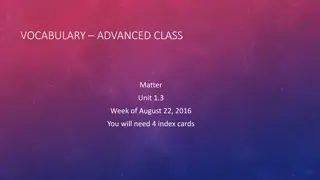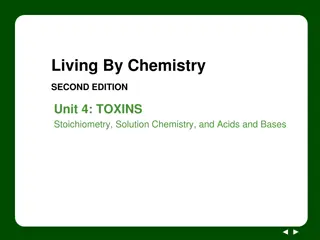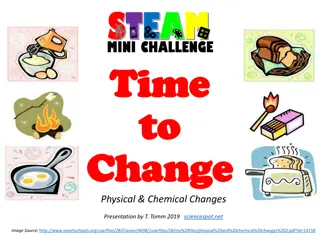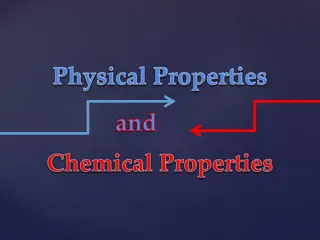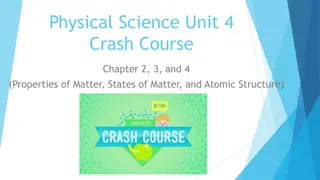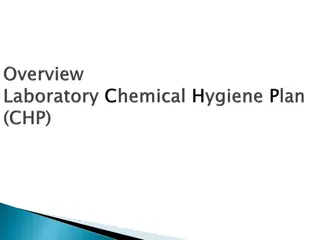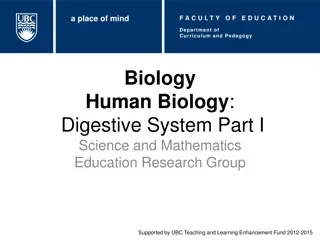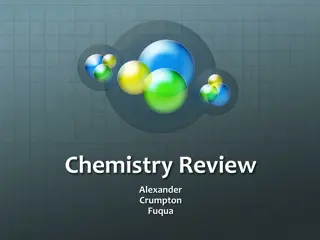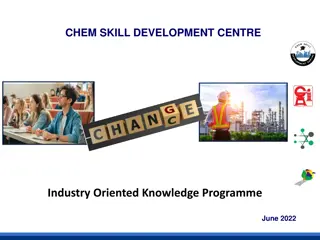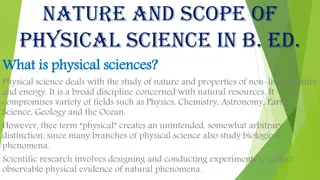Understanding Physical and Chemical Changes in Science Class
Explore the concepts of physical changes and chemical reactions in this interactive science lesson. Students will differentiate between the two types of changes, identify evidence for each, categorize examples, and discuss key concepts with their peers at the table. Through videos and discussions, they will learn about the behavior of molecules in physical and chemical changes, recognize signs of chemical changes, and use the AGAPE method to identify chemical reactions. Engaging activities and discussions will deepen students' understanding of these fundamental scientific concepts.
Download Presentation

Please find below an Image/Link to download the presentation.
The content on the website is provided AS IS for your information and personal use only. It may not be sold, licensed, or shared on other websites without obtaining consent from the author. Download presentation by click this link. If you encounter any issues during the download, it is possible that the publisher has removed the file from their server.
E N D
Presentation Transcript
Targets: *Understand the difference between physical changes and chemical reactions. *Tell evidence of physical changes and chemical reactions. *Categorize changes as physical or chemical, and show examples of each.
Get out a pencil and paper. Add a heading: Name Period ____ Table _____ Physical & Chemical Change You ll be discussing items with your table and taking a few notes.
As you watch the first video, answer this: 1. a. What do molecules do in a PHYSICAL change? b. What do molecules do in a CHEMICAL change?
A. What do MOLECULES do in a physical change? B. What do they do in a chemical change? https://www.youtube.com/watch?v=M8tyjwB42X4
With your table, discuss target #1: *Understand the difference between physical changes and chemical reactions.
As you watch the second video, answer this: 2. What are 5 signs that molecules are probably changing and a chemical change is taking place? A. B. C. D. E.
Signs of a chemical change? https://www.youtube.com/watch?v=37pir0ej_SE
At your table, make sure each person was able to list at least 5 signs of chemical change.
Chemical reactions are sometimes so amazing, they may leave your mouth agape! They aren t always amazing, but AGAPE can help you decide if you are seeing a chemical reaction.
The browning that happens in cooking involves chemical changes:
Look at your list of signs of chemical change. Which are occuring in caramelization ?
With phyiscal change, there is NO CHANGE IN THE MOLECULES that make the substance, so a new substance is not formed. but you can see changes in: size/shape phase density texture (MAY change color)
Are you seeing pysical change or chemical reaction with these changes?
At your table, talk about the change on your card. Be ready to tell the class how you can tell whether it is a physical or chemical change.
On your paper, list an example of a physical change, and tell 3+ signs that help you know it is a physical change. 3. An example of a physical change is _________________. Some signs that this is a physical change are: a. b. c.
On your paper, list an example of a chemical change and give 3+ signs. 4. An example of a chemical change is _______________. Some signs that this is a chemical change are: a. b. c.
Here are our targets. On the top of your paper, by your name, rate yourself from 1 to 4 on how well you have met them. *Understand the difference between physical changes and chemical reactions. *Tell evidence of physical changes and chemical reactions. *Categorize changes as physical or chemical, and show examples of each.



